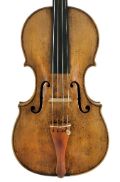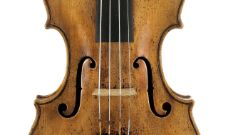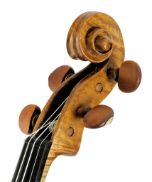Violin, Jacob Stainer, Absam, 1671
Handwritten label: “Jacobus Stainer in Absom / prope Oenipontum mp. 1671”Violins crafted by Jacob Stainer and Nicolò Amati ranked among the most sought-after and therefore most expensive instruments until the late 18th century. Their bright and silvery sound suited the Baroque music ideal as well as the music of the Viennese Classical School, which call for a clear and transparent tone. Stainer’s violin from 1671 exhibits all features that distinguish the master luthier from Absam: the typical body contours, the very harmonious form of the arching, the f-holes and the scroll. Stainer drilled five small, conical holes into the central joint of the back plate that can only be detected in a high-resolution CT scan. He probably used these marks as guidelines for thicknessing the back. Marks of this type can be found only in Stainer’s instruments, making them a unique identifier. The two-piece back has a very fine, regular grain. Both halves of the belly are from the same log, with the most recent annual ring dated 1534. The intense, tight flames of the two-piece, quarter-cut back fan out in an open V shape. A narrow wing was added in the lower bout on the treble side. The ribs are also quarter cut and show a structure corresponding to that of the back. The very gracefully shaped arching of the belly and back begins right at the narrow fluting. The upright f-holes with their perfectly round eyes are typical of Stainer’s work. The purfling is laid very close to the edge and, in keeping with the master luthier’s style, shows magnificently regular, precise workmanship. The very cleanly carved scroll has deeply cut volutes and accurate, sharp edges. Stainer’s varnish is characterized by soft, yellow-brown hues. The varnish is transparent, admirably bringing out the beauty of the wood. The overall condition of the instrument is very good.
Very little is known about this instrument’s history. A brand stamp can be found below the button on the back, presumably from a previous owner who has not been identified.






